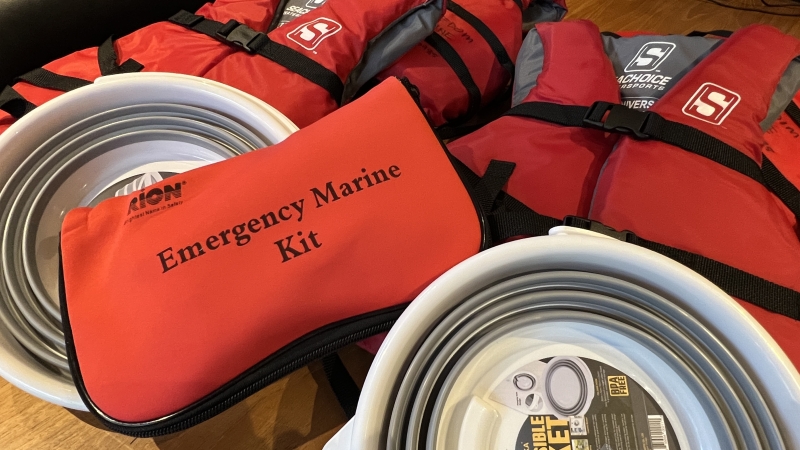What’s in Your Ditch Bag?
15th October 2024
Most responsible mariners stock an Emergency Bag (also called a “ditch bag”, “ditch kit”, or “grab bag”) with additional emergency supplies to take along in case of an abandonment. It needs to be stowed where it can quickly and easily be grabbed and thrown into a life raft. A ditch bag should be waterproof and brightly colored, with a lanyard attached just in case it slips out of your fingers.
The question of what supplies to place in the bag provides plenty of stimulating discussion among sailors and boat owners. How much do you really need is always an interesting topic.
British Columbia coastal cruisers don’t need to be anticipate spending an extended period on an abandoned island, but it would be wise to prepare enough supplies that would last at least a couple of days.
Remaining warm is basic to survival. Staying dry, or getting dry, is an enormous factor in staying warm. Exposure to direct sunlight can produce uncomfortable and even debilitating results. Ensure that ALL your equipment is rigged with a lanyard so that it can be connected to the bag or a wrist tether as appropriate. Sealing items in plastic bags can also be extremely helpful.
The time to prepare a ditch bag is when you are absolutely sure you will never need one. Thankfully, most cruisers will never have to abandon a sinking vessel. But in the time of an emergency there is no way or time you will be able to gather everything you will need.

British Columbia’s coastal cruisers will need a ditch bag that is slightly different than one more appropriate for an offshore, transoceanic sailor. Clearly, a set of dry clothes in a waterproof bag will be of greater importance to a drifting pleasure craft in the Pacific Northwest than a spear gun or survival fishing kit. A well-prepared ditch back will address four basic survival needs – communications and signaling; personal nutrition and hydration; preventing hypothermia and sunstroke; and dealing with injuries. Suggested items to be include in a ditch bag are:
- Personal location beacon or Search and Rescue Transponder
- Portable GPS unit
- Strobe light
- Laser signaling device
- Waterproof handheld VHF radio
- Aerial flares
- Handheld flares
- Signal mirror
- Loud whistle
- Handheld compass
- Head Lamp
- Waterproof flashlight
- Survival knife
- Parachute cord
- Zip-Lock bags
- Multi-tool
- Extra batteries
- At least a gallon of fresh water
- Rationing cup
- 2 or 3 Energy Bars per person
- Fire starter (waterproof lighter)
- Long sleeved shirt, long pants, and socks per person
- Wide brimmed hat
- Jacket
- Sunglasses
- Chapstick
- Sunscreen
- Survival blankets
- Chemical hand warmer heat packs
- First Aid kit
- Life sustaining prescription drugs in waterproof container
Other consideration is to ensure the life raft and or dinghy is always ready. Periodic inspection to ensure that the resources remain on hand and in good condition should be a routine task for any coastal cruiser. When preparing to ditch, you will rely on the following items be aboard your life raft or tender:
- Personal Flotation Devices (PFDs)
- A bailing bucket and/or manual bilge pump
- Patch kit (for inflatables)
- Hand or foot-operated air pump (for Inflatables) transom plug, with tether
- Oars in good condition
- Fresh fuel, if lifeboat is motorized
- Starting battery, if motorized
- Compressed air horn
- 25-feet of stout line
- Adequate anchor and rode
This list is not exhaustive, and every skipper will have different ideas about the equipment they prioritize as essential. Check your ditch bag yearly to replace batteries and restock out-of-date food and flares. Going though the process will provide you the chance to review our gear to ensure it still meets your needs and will keep you and your crew alive until rescue arrives.


